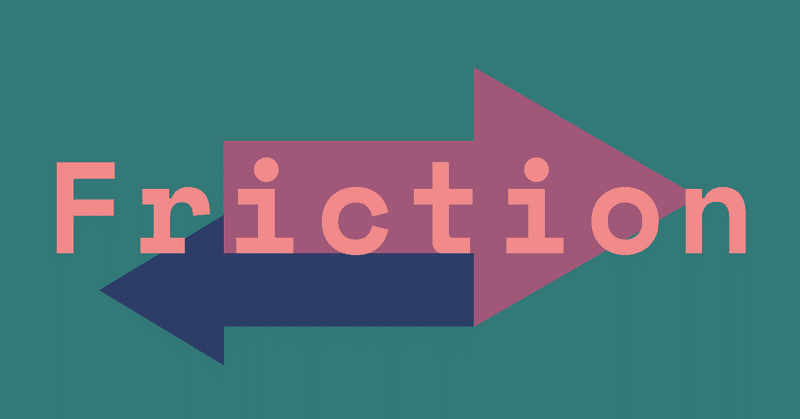
良い摩擦(Friction)について
Frictionとは力学における摩擦のことですが、より一般的に物事が進むのを妨げる力であったり、人間同士の不和などを指しても使います。デザインの現場ではユーザが何かのタスクを行うのを妨げ、進みを遅くしたり(slower progress)より多くの労力(greater effort)を要求してしまうという意味でよく使われます。
Friction in UX acts between the user and a product: While a user tries to complete a task, the force of friction acts in the opposite direction, backward. As a result, our user’s progress is slower, and he has to use greater effort to move forward and complete the task.
Friction as a Function In User ExperienceというMediumの記事を読んでみます。ここではFunction(機能)とあるようにFrictionが役に立つ例が挙げられています。
Don’t Make Me Think
まずSteve Krugの有名な書籍、Don't make me thinkのタイトルを引用してFrictionがない状態(Frictionless)な状態が説明されます。
ユーザーにとってはマニュアルを読まなくても操作できること、できるだけ意思決定の数を減らし、頑張らなくても理解できるようにする(least cognitive effort = 最低の認知努力)こと。
For users, “don’t make me think” means we shouldn’t need an instruction manual to operate the UI. It also means making the least number of decisions and using the least cognitive effort possible.
UXデザイナーにとっては、よく知られたパターン(known patterns)、定番の手法(standards)を用い一貫性を持たせること。確かで直感的なロジックを作り上げユーザを慣れさせること。視覚的な負荷(visual load)を減らすこと、良い情報の階層(good information hierarchy)を作り上げること。などなど。
For UX designers, “don’t make me think” means incorporating known patterns into our designs, using common UX standards, applying consistency, and creating a solid, intrinsic system logic to make users establish habits. It also means decreasing visual load, creating good information hierarchy, etc.
摩擦ゼロが常に良いとは限らない
しかし筆者はここで警鐘を鳴らします。原則がいつも正しいは限りません。
I’ve realized that when it comes to complex systems that control critical functionality, the fast, easy, and standard way of doing things is not always the best for users.
When there is limited friction, everything goes smoothly—maybe too smoothly.
特に重要な(critical)機能に関しては速くて簡単な定番の方法がいつも最適とは限らない。摩擦がないとスムーズすぎてしまうかもしれません。
Criticalはただ「重要」ではなく何か重大な結果に至る分岐点というニュアンスで覚えておくと良いです。間違えると大惨事になるような決断(critical decision)、あるとないとでは天と地ほどの差が出る能力(critical ability)、核の「臨界」はcriticalityです。
次の節では従来の常識(conventional rules of thumb)に対して、あえてFrictionを増やした方がいいケースの例が三つ挙げられています。どんなケースでしょうか。ちょっと予想してからぜひ原文を読んでみてください。
rules of thumbは経験に基づいて、一般に正しく役に立つと認知されているルールのことです。このフレーズはよく使われるので覚えておくと便利です。
a broadly accurate guide or principle, based on experience or practice rather than theory.
ルールは常に正しいとは限らない
ルールやガイドラインは便利ですが、理由を考えずに盲目的に使ってしまうと大事なことを見逃すこともあります。「このルールはどんな時に適用できないか」と考えてみることはそのルールをより良く理解して役立てるヒントになります。Material DesignやHuman Interface Guidelinesに目を通すこと、というのはよくあるアドバイスですが、読む時にあえて批判的に読んでみるのも良いかもしれません。
この記事が気に入ったらサポートをしてみませんか?
